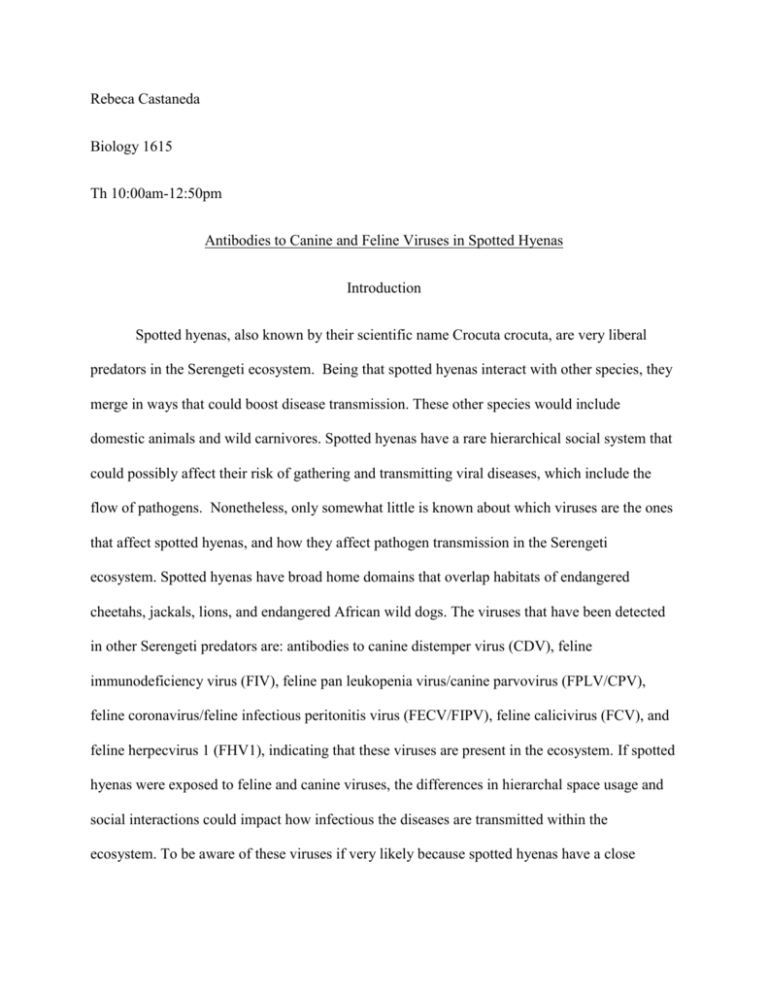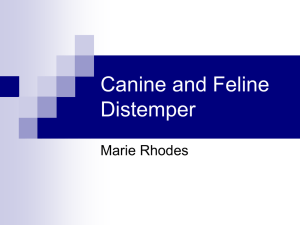File - Rebeca Castaneda
advertisement

Rebeca Castaneda Biology 1615 Th 10:00am-12:50pm Antibodies to Canine and Feline Viruses in Spotted Hyenas Introduction Spotted hyenas, also known by their scientific name Crocuta crocuta, are very liberal predators in the Serengeti ecosystem. Being that spotted hyenas interact with other species, they merge in ways that could boost disease transmission. These other species would include domestic animals and wild carnivores. Spotted hyenas have a rare hierarchical social system that could possibly affect their risk of gathering and transmitting viral diseases, which include the flow of pathogens. Nonetheless, only somewhat little is known about which viruses are the ones that affect spotted hyenas, and how they affect pathogen transmission in the Serengeti ecosystem. Spotted hyenas have broad home domains that overlap habitats of endangered cheetahs, jackals, lions, and endangered African wild dogs. The viruses that have been detected in other Serengeti predators are: antibodies to canine distemper virus (CDV), feline immunodeficiency virus (FIV), feline pan leukopenia virus/canine parvovirus (FPLV/CPV), feline coronavirus/feline infectious peritonitis virus (FECV/FIPV), feline calicivirus (FCV), and feline herpecvirus 1 (FHV1), indicating that these viruses are present in the ecosystem. If spotted hyenas were exposed to feline and canine viruses, the differences in hierarchal space usage and social interactions could impact how infectious the diseases are transmitted within the ecosystem. To be aware of these viruses if very likely because spotted hyenas have a close phylogenetic relationship. The reason for this study was to ordain whether or not spotted hyenas had also been infected with these viruses and to figure out the risk factors for infection. Materials and Methods Between 1993 and 2001, blood samples were collected from spotted hyenas in the Talek clan, which consisted of 119 hyenas. Blood samples were also collected from nine other groups of spotted hyenas, which consisted of 121, in a combination of behavior and genetic studies in the Serengeti ecosystem. All of the animals inhabited in the Maasai Mara National Reserve (MMNR). The blood samples used in this study were collected from the jugular vein and they were separated into cell components and serum. The serum samples collected were stocked in liquid nitrogen, shipped in dry ice, and subsequently reserved at -80 degrees Celsius in the lab of where the study took place. It was kept there until the serum was analyzed. All serologic evaluations were done at the New York State Animal Health Diagnostic Laboratory. Serumneutralizing antibodies against CDV were measured by a tool called the Onderstepoort strain. If the titers on the Onderstepoort appeared greater then 1:10, it meant that it was considered positive for CDV. For the other viruses FECV/FIPV, FCV, and FHV1, sera were tested with a micro plate serum neutralization technique, comparable to the CDV test that was done, along with some adjustments. The spotted hyenas were grouped by certain categories, most of which consisting of age class: juvenile 5-4 months old (84 hyenas), adult 2-16.5 months old (153 hyenas), and unknown age (3 hyenas), sex: female (130 hyenas) and male (110 hyenas), and social rank: high ranking Talek clan female and their juvenile cubs (38 hyenas), medium- and low ranking Talek clan female and their juvenile cubs (54 hyenas), adult low ranking Talek clan males (24 hyenas), and unknown ranking of Talek clan members (3 hyenas). Results The results from the study done, showed that the antibody prevalence was much greater in the adult hyenas for FIV and FECV/FIPV than any other ages of the hyenas. A female spotted hyena of high social rank was indeed to be found as a risk factor for FIV, in contrast to hyenas near human habitation that apparently appeared to be at lower risk to have CDV, FIV, and FECV/FIPV antibodies. While FPLV/CPV antibodies where at risk for spotted hyenas near the human habitation. The canine distemper disease and FECV/FIPV antibody prevalence varied significantly over time, while FIV, FPLV/CPV, and FCV had a stable temporal pattern. These results reveal that spotted hyenas could possibly play a role in the ecology of these viruses in the Serengeti ecosystem. Conclusion/Discussion This study indicates that free-ranging spotted hyenas in the Maasai Mara National Reserve (MMNR) become infected and are exposed to canine and feline viruses. It is suggested that the results of these viruses should be further researched in order to get a much more thorough answer. Unfortunately, this evidence of infection demonstrates that whether hyenas are a reservoir for these viruses, or are exposed by another wildlife species that is not known. The age issue might be an outcome of exposure during previous epidemics, or it could be because it is more likely that the viruses will encounter overtime during the hyenas lifetime. From this study, the results propose that domestic animals associated with the Maasai manyattas are not the sole source for CDV, FIV, and FECV/FIPV.







